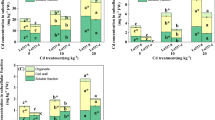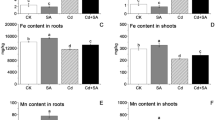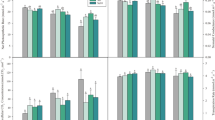Abstract
Ramie (Boehmeria nivea L.) is an industrial crop for the heavy metal-polluted farmland in south China due to its high tolerance and accumulation ability of heavy metals. To investigate if antioxidation enzymes and heavy metal chelators are synergism defense mechanisms of cadmium, YJ, a low-Cd-accumulating, and DY, a high-Cd-accumulating ramie cultivar, were cultivated with increasing concentrations of cadmium such as 0, 5, 25 and 50 mg/L. The Cd accumulation and distribution, oxidation stress, glutathione (GSH), phytochelatins (PCs) as well as the level of the transcripts that encode glutamate-cysteine ligase (GCL) and phytochelatin synthase (PCS) were determined. After 7 days of Cd exposure, we found that the higher Cd accumulation in DY was associated with higher antioxidative enzyme activities, suggesting that antioxidative enzymes were the crucial factors associated with the diversity in Cd cumulation. YJ suffered less oxidative stress, while higher root activities and soluble protein content, along with higher contents of GSH and PCs were identified in YJ under Cd exposure, particularly under high dose of Cd exposure. Failing to detoxify overmuch Cd owing to GSH and PCs limitation as well as the downregulation of BnGCL1 and BnPCS1 might cause the lower tolerance identified in DY. The results herein reveal that Cd detoxification of the YJ cultivar happened primarily through the regulation of gene expression, increased GSH content, and PCs content, which sequestered Cd in the roots and decreased Cd translocation to the shoots. Furthermore, we infer that the ramie cultivar has evolved different strategies to realize the detoxification of Cd and to tackle the corresponding oxidation stress.







Similar content being viewed by others
Data availability
The data that support the findings of this study are available from the corresponding author on reasonable request.
References
Alamri S, Kushwaha BK, Singh VP, Siddiqui MH (2020) Dose-dependent differential effects of toxic metal cadmium in tomato roots: Role of endogenous hydrogen sulfide. Ecotoxicol Environ Saf. https://doi.org/10.1016/j.ecoenv.2020.110978
Anjum NA, Hasanuzzaman M, Hossain MA, Thangavel P, Roychoudhury A, Gill SS, Rodrigo MAM, Adam V, Fujita M, Kizek R, Duarte AC, Pereira E, Ahmad I (2015) Jacks of metal/metalloid chelation trade in plants-an overview. Front Plant Sci 6:192
Ashraf M (2009) Biotechnological approach of improving plant salt tolerance using antioxidants as markers. Biotechnol Adv 27:84–93
Bączek-Kwinta R, Antonkiewicz J, Łopata-Stasiak A, Kępka W (2019) Smoke compounds aggravate stress inflicted on Brassica seedlings by unfavourable soil conditions. Photosynthetica 57(1):1–8
Clemens S (2006) Toxic metal accumulation, responses to exposure and mechanisms of tolerance in plants. Biochimie 88:1707–1719
Clemensson Lindell A (1994) Triphenyltetrazolium chloride as an indicator of fine-root vitality and environmental stress in coniferous forest stands: applications and limitations. Plant Soil 159:297–300
Cobbett C, Goldsbrough P (2002) Phytochelatins and metallothioneins: roles in heavy metal detoxification and homeostasis. Annu Rev Plant Biol 53:159–182
Delalande O, Desvaux H, Godat E, Valleix A, Junot C, Labarre J, Boulard Y (2010) Cadmium-glutathione solution structures provide new insights into heavy metal detoxification. FEBS J 277:5086–5096
Fernández R, Bertrand A, Reis R, Mourato MP, Martins LL, González A (2013) Growth and physiological responses to cadmium stress of two populations of Dittrichia viscosa (L.) Greuter. J Hazard Mater 15:244–255
Gao M, Zhou J, Liu H, Zhang W, Hu Y, Liang J, Zhou J (2018) Foliar spraying with silicon and selenium reduces cadmium uptake and mitigates cadmium toxicity in rice. Sci Total Environ 631:1100–1108
Gill SS, Tuteja N (2010) Reactive oxygen species and antioxidant machinery in abiotic stress tolerance in crop plants. Plant Physiol Biochem 48:909–930
Gill SS, Khan NA, Tuteja N (2012) Cadmium at high dose perturbs growth, photosynthesis and nitrogen metabolism while at low dose it up regulates sulfur assimilation and antioxidant machinery in garden cress (Lepidium sativum L.). Plant Sci 182:112–120
Guo JJ, Qin SY, Rengel Z, Gao W, Nie ZJ, Liu HG, Lia C, Zhao P (2019) Cadmium stress increases antioxidant enzyme activities and decreases endogenous hormone concentrations more in Cd-tolerant than Cd-sensitive wheat varieties. Ecotoxicol Environ Saf 172:380–387
Gupta DK, Huang HG, Yang XE, Razafindrabe BHN, Inoue M (2010) The detoxification of lead in Sedum alfredii is not related to phytochelatins but the glutathione. J Hazard Mater 177:437–444
Hernández LE, Sobrino-Plata J, Montero-Palmero MB, Carrasco-Gil S, Flores Cáceres ML, Ortega-Villasante C, Escobar C (2015) Contribution of glutathione to the control of cellular redox homeostasis under toxic metal and metalloid stress. J Exp Bot 66:2901–2911
Hicks LM, Cahoon RE, Bonner ER, Rivard RS, Sheffield J, Jez JM (2007) Thiol-based regulation of redox-active glutamate-cysteine ligase from Arabidopsis thaliana. Plant Cell 19:2653–2661
Ishikawa S, Ishimaru Y, Igura M, Kuramata M, Abe T, Senoura T, Hase Y, Arao T, Nishizawa NK, Nakanishi H (2012) Ion-beam irradiation, gene identification, and marker-assisted breeding in the development of low-cadmium rice. Proc Natl Acad Sci 109:19166–19171
Jez JM, Cahoon RE, Chen S (2004) Arabidopsis thaliana glutamate-cysteine ligase: Functional properties, kinetic mechanism, and regulation of activity. J Biol Chem 279:33463–33470
Joseph MJ, Rebecca EC, Chen SX (2004) Arabidopsis thaliana glutamate-cysteine ligase: functional properties, kinetic mechanism, and regulation of activity. J Biol Chem 32:33463–33470
Jozefczak M, Remans T, Vangronsveld J, Cuypers A (2012) Glutathione is a key player in metal-induced oxidative stress defenses. Int J Mol Sci 13:3145–3175
Lee BD, Hwang S (2015) Tobacco phytochelatin synthase (NtPCS1) plays important roles in cadmium and arsenic tolerance and in early plant development in tobacco. Plant Biotechnol Rep 9:107–114
Li X, Zhang L, Li Y, Ma L, Bu N, Ma C (2012) Changes in photosynthesis, antioxidant enzymes and lipid peroxidation in soybean seedlings exposed to UV-B radiation and/or Cd. Plant Soil 352:377–387
Li MG, Stragliati L, Bellini E, Ricci A, Saba A, Sanità di Toppi L, Varotto C (2019) Evolution and functional differentiation of recently diverged phytochelatin synthase genes from Arundo donax L. J Exp Bot 70:5391–5405
Lu Z, Zhang Z, Su Y, Liu C, Shi G (2013) Cultivar variation in morphological response of peanut roots to cadmium stress and its relation to cadmium accumulation. Ecotoxicol Environ Saf 91:147–155
Massoud MB, Sakouhi L, Karmous I, Zhu Y, Ferjani EE, Sheehan D, Chaoui A (2018) Protective role of exogenous phytohormones on redox status in pea seedlings under copper stress. J Plant Physiol 221:51–61
Meng Y, Zhang L, Wang LQ, Zhou CJ, Shangguan YX, Yang Y (2019) Antioxidative enzymes activity and thiol metabolism in three leafy vegetables under Cd stress. Ecotoxicol Environ Saf 173:214–224
National Ecological Environment Quality Profile. Ministry of Ecology and Environment of the People’s Republic of China. https://www.mee.gov.cn/xxgk2018/xxgk/xxgk15/202005/t20200507_777895.html. Accessed 7 May 2020
Noble JE, Knight AE, Reason AJ, Di Matola A, Bailey MJ (2007) A comparison of protein quantitation assays for biopharmaceutical applications. Mol Biotechnol 37:99–111
Nualla-ong A, Phongdara A, Buapet P (2020) Copper and zinc differentially affect root glutathione accumulation and phytochelatin synthase gene expression of Rhizophora mucronata seedlings: Implications for mechanisms underlying trace metal tolerance. Ecotoxicol Environ Saf 205:111175
Polak N, Read DS, Jurkschat K, Matzke M, Kelly FJ, Spurgeon DJ, Stürzenbaum SR (2014) Metalloproteins and phytochelatin synthase may confer protection against zinc oxide nanoparticle induced toxicity in Caenorhabditis elegans. Comp Biochem Physiol 160:75–85
Rizwan M, Ali S, Abbas T, Zia-ur-Rehman M, Hannan F, Keller C, Al-Wabel MI, Ok YS (2016) Cadmium minimization in wheat: a critical review. Ecotoxicol Environ Saf 130:43–53
Rizwan M, Ali S, Adrees M, Ibrahim M, Tsang DC, Zia-ur-Rehman M, Ok YS (2017) A critical review on effects, tolerance mechanisms and management of cadmium in vegetables. Chemosphere 182:90–105
Saed-Moucheshi A, Shekoofa A, Pessarakli M (2014) Reactive oxygen species (ROS) generation and detoxifying in plants. J Plant Nutr 37:1573–1585
Sanità di Toppi L, Pawlik-Skowronska B, Vurro E, Vattuone Z, Kalinowska R, Restivo FM, Musetti R, Skowronski T (2008) First and second linemechanisms of cadmium detoxification in the lichen photobiont Trebouxia impressa (Chlorophyta). Environ Pollut 151:280–286
Saraswat S, Rai JPN (2011) Mechanism of metal tolerance and detoxification in mycorrhizal fungi. In: Khan MS, Zaidi A, Goel R, Musarrat J (eds) Biomanagement metal-contaminated soils, vol 20. Springer Netherlands, Dordrecht, pp 225–240
Sasaki A, Yamaji Y, Yokosho K, Ma JF (2012) Nramp5 is a major transporter responsible for manganese and cadmium uptake in rice. Plant Cell 24:2155–2167
Sghayar S, Ferri A, Lancilli C, Lucchini G, Abruzzese A, Porrini M, Ghnaya T, Nocito FF, Abdelly C, Sacchi GA (2015) Analysis of cadmium translocation, partitioning and tolerance in six barley (Hordeum vulgare L.) cultivars as a function of thiol metabolism. Biol Fert Soils 51:311–320
Sharma P, Ambuj BJ, Rama SD, Mohammad P (2012) Reactive oxygen species, oxidative damage, and antioxidative defense mechanism in plants under stressful conditions. J Bot 2012:217037
She W, Jie YC, Xing HC, Lu YW, Kang WL (2011) Absorption and accumulation of cadmium by ramie (Boehmeria nivea) Cultivars: A Field Study. Acta Agricul Scandina 61:641–647
She W, Cui GX, Li XL, Su XH, Jie YC, Yang RF (2018) Characterization of cadmium concentration and translocation among ramie cultivars as affected by zinc and iron deficiency. Acta Physiol Plant 40:104
Sytar O, Kumar A, Latowski D, Kuczynska P, Strzałka K, Prasad MNV (2013) Heavy metal-induced oxidative damage, defense reactions, and detoxification mechanisms in plants. Acta Physiol Plant 35:985–999
Tarhan L, Kavakcioglu B (2015) Glutathione metabolism in Urtica dioica in response to cadmium based oxidative stress. Biol Plant 60:1–10
Vingiani GM, Gasulla F, Barón-Sola Á, Sobrino-Plata J, Luis EH, Casano LM (2021) Physiological and molecular alterations of phycobionts of genus Trebouxia and Coccomyxa exposed to Cadmium. Microb Ecol 82:334–343
Wang X, Liu YG, Aibibu N, Zhang DM, Xu WH, Zhou M, Chai LY (2007) Endurance mechanism of ramie to cd and the alleviating effect of exogenous spermine. J Agro-Environt Sci 26:487–493
Wang X, Liu YG, Zeng GM, Chai LY, Song XC, Min ZY, Xiao X (2008) Subcellular distribution and chemical forms of cadmium in Bechmeria nivea L. Gaud Environ Exp Bot 62:389–395
Wang FJ, Wang M, Liu ZP, Shi Y, Han TQ, Ye YY, Gong N, Sun JW, Zhu C (2015) Different responses of low grain-Cd-accumulating and high grain-Cd accumulating rice cultivars to Cd stress. Plant Physiol Biochem 96:261–269
Wu ZC, Zhao XH, Sun XC, Tan QL, Tang YF, Nie ZJ, Qu CJ, Chen ZX, Hu CH (2015) Antioxidant enzyme systems and the ascorbate–glutathione cycle as contributing factors to cadmium accumulation and tolerance in two oilseed rape cultivars (Brassica napus L.) under moderate cadmium stress. Chemosphere 138:526–536
Yamazaki S, Ueda Y, Mukai A, Ochiai K, Matoh T (2018) Rice phytochelatin synthases OsPCS1 and OsPCS2 make different contributions to cadmium and arsenic tolerance. Plant Direct. https://doi.org/10.1002/pld3.34
Yang B, Zhou M, Shu WS, Lan CY, Ye ZH, Qiu RL, Jie YC, Cui GX, Wong MH (2010) Constitutional tolerance to heavy metals of a fiber crop, ramie (Boehmeria nivea), and its potential usage. Environ Pollut 158:551–558
Acknowledgements
This research was supported by the National Natural Science Foundation of China (Grant No. 31871673) and China Agriculture Research System of MOF and MARA; CARS for Bast and Leaf Fiber Crops (CARS-16-E11).
Author information
Authors and Affiliations
Corresponding authors
Ethics declarations
Conflict of interest
The authors declare that they have no known competing financial interests or personal relationships that could have appeared to influence the work reported in this paper.
Additional information
Communicated by S. Esposito.
Publisher's Note
Springer Nature remains neutral with regard to jurisdictional claims in published maps and institutional affiliations.
Supplementary Information
Below is the link to the electronic supplementary material.
Rights and permissions
Springer Nature or its licensor (e.g. a society or other partner) holds exclusive rights to this article under a publishing agreement with the author(s) or other rightsholder(s); author self-archiving of the accepted manuscript version of this article is solely governed by the terms of such publishing agreement and applicable law.
About this article
Cite this article
She, W., Xing, H., Quan, R. et al. Different strategies of Cd tolerance and accumulation in low-Cd-accumulating and high-Cd-accumulating ramie cultivars. Acta Physiol Plant 45, 143 (2023). https://doi.org/10.1007/s11738-023-03621-9
Received:
Revised:
Accepted:
Published:
DOI: https://doi.org/10.1007/s11738-023-03621-9




